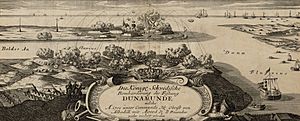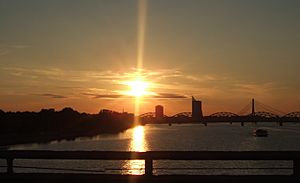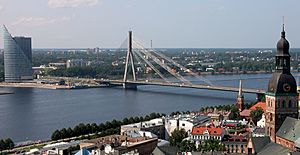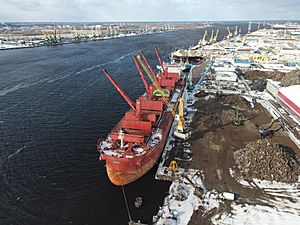Daugava facts for kids
Quick facts for kids Daugava |
|
|---|---|

The drainage basin of the Daugava
|
|
| Other name(s) | Western Dvina |
| Country | Belarus, Latvia, Russia |
| Physical characteristics | |
| Main source | Valdai Hills, Russia 221 m (725 ft) |
| River mouth | Gulf of Riga, Baltic Sea 0 m (0 ft) 57°3′42″N 24°1′50″E / 57.06167°N 24.03056°E |
| Length | 1,020 km (630 mi) |
| Basin features | |
| Basin size | 87,900 km2 (33,900 sq mi) |
The Daugava is a major river in Eastern Europe. It is also known as the Western Dvina. This river starts in the Valdai Hills in Russia. It then flows through Belarus and Latvia. Finally, it empties into the Gulf of Riga, which is part of the Baltic Sea.
The Daugava is about 1,020 km (630 mi) long. A big part of it, 352 km (219 mi), flows through Latvia. Another 325 km (202 mi) is in Russia. The river flows west and makes a large curve as it goes through northern Belarus. Riga, the capital city of Latvia, is built on both sides of the river. The city center is about 15 kilometres (9.3 mi) from where the river meets the sea. Riga is also a very important port city.
Contents
Where Does the Daugava River Flow?
The Daugava River's total drainage area is very large. It covers about 87,900 km2 (33,900 sq mi). A significant part of this area, 33,150 km2 (12,800 sq mi), is located within Belarus. This means that all the rain and snow that falls in this huge area eventually flows into the Daugava River.
What Rivers Join the Daugava?
Many smaller rivers flow into the Daugava. These are called tributaries. They add water to the main river as it travels.
- On the left side (from where the Daugava starts to where it ends):
- Mezha
- Kasplya
- Dysna
- Laucesa
- Berezauka
- Eglona
- Pikstere
- Ņega
- On the right side:
- Usvyacha
- Palata
- Drysa
- Dubna
- Aiviekste
- Pērse
- Dīvaja
- Ogre
What Does the Name Daugava Mean?
The name "Dvina" (another name for Daugava) likely comes from an ancient Indo-European word. This word probably meant "river" or "stream." Some experts think it's similar to the name of the Danube River. The word "Danube" comes from a very old word meaning "large river."
The names for the river in Livonian (Vēna), Estonian (Väinajogi), and Finnish (Väinäjoki) have a different origin. They come from a Proto-Finnic word. This word means "a large, peacefully rolling river."
A Brief History of the Daugava River

People have lived near the mouth of the Daugava River for thousands of years. They used the river for fishing and gathering food. Around the 6th century CE, Viking explorers traveled across the Baltic Sea. They used the Daugava River to go deep into the land.
In medieval times, the Daugava was a very important trade route. It was part of the famous trade route from the Varangians to the Greeks. This route helped transport valuable furs from the north. It also brought silver from the south, from the Byzantine Empire. The area around Riga became a key place for trade and defense. This was especially true for the Finnic-speaking Livs people.
Over time, different groups and countries ruled the western part of the Daugava basin. For example, the Latvian city of Daugavpils was ruled by different powers. These included religious leaders, Slavs, Poles, Germans, and Russians. This changed when Latvia became independent again in 1990.
Cities and Towns Along the Daugava

Many cities and towns have grown up along the Daugava River. Here are some of them:
Cities in Russia
- Andreapol
- Zapadnaya Dvina
- Velizh
Cities in Belarus
Cities in Latvia
The Daugava River's Environment
The Daugava River has faced some environmental challenges. During the Soviet era, farming practices and power plants caused pollution. This affected the river's health.
How Clean is the Water?
Upstream from the Latvian town of Jekabpils, the river water is slightly alkaline. It contains minerals like calcium and nutrients like nitrates and phosphates. The high levels of nitrates and phosphates in the Daugava contribute to the growth of too much plant life in the Baltic Sea. Other rivers like the Oder and Vistula also add to this issue.
In Belarus, the Daugava's water pollution is considered moderate. The main sources of this pollution are treated wastewater, fish farms, and chemicals from farms. These chemicals include things like herbicides, pesticides, nitrates, and phosphates.
See also
 In Spanish: Río Daugava para niños
In Spanish: Río Daugava para niños



